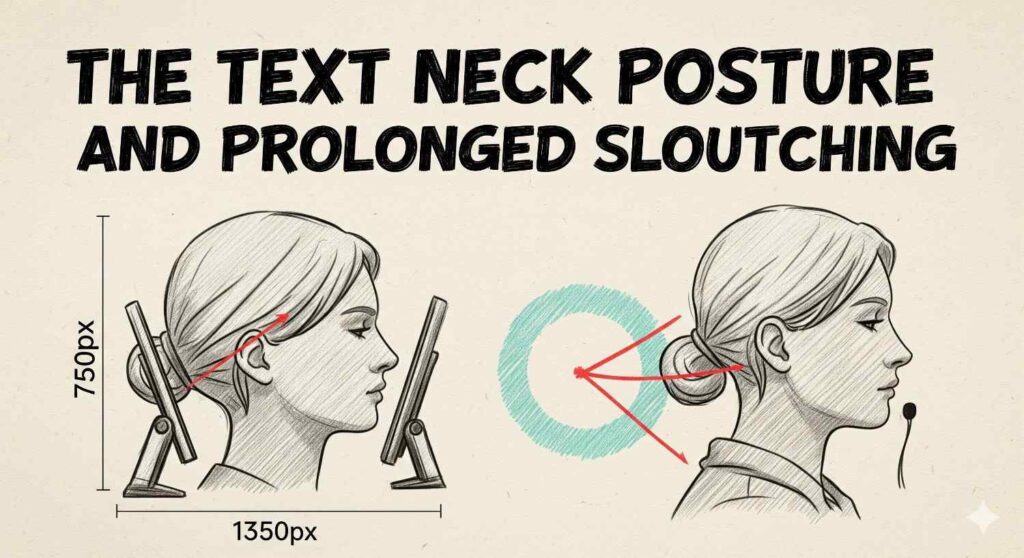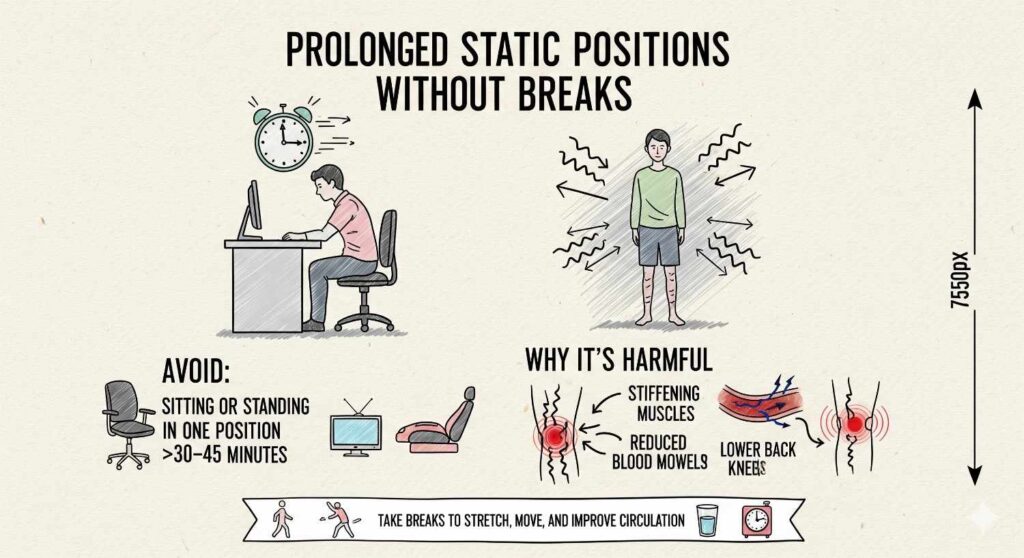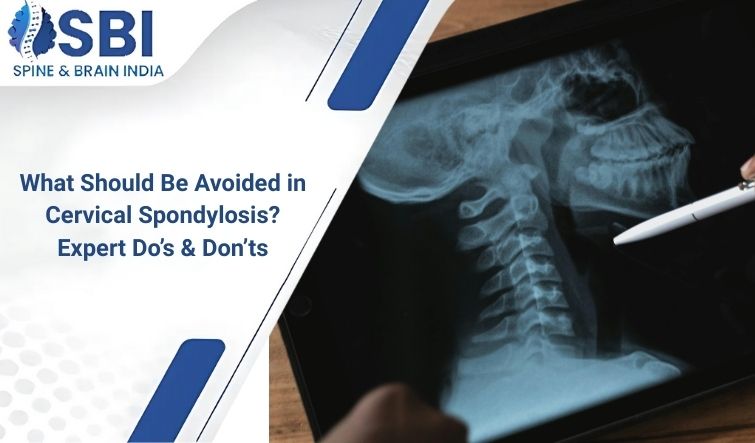Have you ever felt that nagging stiffness or persistent ache in your neck, perhaps accompanied by a tingling sensation in your arms or a headache that just won’t quit? If so, you’re not alone. Cervical spondylosis, a very common age-related condition resulting from the wear and tear of the cervical (neck) vertebrae and discs, is a source of daily discomfort for millions. While it can’t always be prevented, its symptoms can certainly be managed and prevented from worsening. The key lies in understanding a simple but powerful principle: what you do and, perhaps even more importantly, what should be avoided in cervical spondylosis.
Living with this condition requires a proactive approach. It’s not about a magic cure but about making mindful, consistent choices every single day that support the health of your cervical spine. The wrong habits can exacerbate your pain, accelerate the degenerative process, and worsen your symptoms. On the flip side, the right habits can provide significant relief, improve your mobility, and restore your quality of life. This guide will serve as your comprehensive expert-backed roadmap to navigating this condition, clarifying what should be avoided in cervical spondylosis and what habits you should embrace.
The Foundational “Don’ts”: What Should Be Avoided in Cervical Spondylosis
Let’s begin with the crucial list of habits and activities that you must avoid or modify to prevent flare-ups and protect your neck. These are the primary actions that exacerbate the pain and progression of cervical spondylosis.
1. The “Text Neck” Posture and Prolonged Slouching

In our modern world, this is arguably the number one culprit for neck strain. Bending your head forward to look at a phone, tablet, or laptop places an immense amount of stress on your neck. For every inch you tilt your head forward, the weight your neck has to support can increase by 10 pounds or more. This constant strain on your cervical vertebrae and muscles is precisely what should be avoided in cervical spondylosis.
- Avoid: Spending long periods looking down at your phone or computer. Slouching in a chair with your shoulders rounded forward.
- Why it’s harmful: This posture puts excessive pressure on the cervical discs, accelerates their degeneration, and causes chronic muscle tension, leading to stiffness and pain. It can also compress nerves, causing radiating pain and numbness.
2. High-Impact Activities and Exercises
While exercise is generally beneficial, certain types can be detrimental to a sensitive neck. Activities that involve jarring or repeated impact can put significant stress on the spinal discs and joints.
- Avoid: Running on hard surfaces, jumping, contact sports, or lifting very heavy weights (especially with improper form). Any activity that causes a sudden, jerky movement of the neck is also what should be avoided in cervical spondylosis.
- Why it’s harmful: The repetitive shock from these activities can accelerate the wear and tear on your already compromised cervical discs and facet joints. It can also aggravate existing nerve compression or inflammation.
3. Improper Lifting and Carrying of Heavy Objects
How you lift and carry things can have a ripple effect on your entire spine, including your neck.
- Avoid: Carrying a heavy bag or purse on one shoulder, as this creates a chronic imbalance and forces your neck muscles to overcompensate. Lifting heavy objects from the floor with your back and neck, rather than your legs, is also a definite no.
- Why it’s harmful: This puts uneven strain on your neck and shoulder muscles. When you lift improperly, the stress on your cervical spine can be significant, potentially leading to a muscle sprain, a disc injury, or a severe pain flare-up.
Struggling with Cervical Spondylosis?
Get expert guidance from Dr. Arun Saroha, a renowned spine & neurosurgeon with 25+ years of experience. Discover what to avoid, what to do, and the safest treatment options to live pain-free.
Book Your Consultation Today4. Awkward Sleeping Positions and Unsupportive Pillows
You spend a third of your life sleeping, and an improper sleeping setup can undo all your good habits from the day.
- Avoid: Sleeping on your stomach, as it forces you to turn your head to one side for an extended period, severely straining your neck joints and muscles. Using a pillow that is either too high or too low is also what should be avoided in cervical spondylosis.
- Why it’s harmful: A misaligned neck position during sleep can lead to stiffness, pain, and headaches upon waking. It can aggravate inflammation and put sustained pressure on your cervical nerves.
5. Prolonged Static Positions Without Breaks

Whether you’re working at a desk, watching TV, or in a car, staying in the same position for too long can cause stiffness and discomfort.
- Avoid: Remaining seated or standing in one position for more than 30-45 minutes without a break. This is particularly crucial for those with jobs that require long hours at a computer.
- Why it’s harmful: Muscles and joints become stiff and lose their natural flexibility when they are not moved. This lack of movement reduces blood flow to the area and can intensify chronic pain.
6. Ignoring Pain or “Pushing Through It”
Your body’s pain signals are its way of telling you that something is wrong. Ignoring these signals and pushing through activities that cause discomfort can be very harmful.
- Avoid: Continuing an activity that causes a sharp or increasing pain in your neck or radiating into your arms.
- Why it’s harmful: Continuing an activity while in pain can worsen a minor irritation into a serious injury, potentially leading to chronic nerve damage or muscle spasms. Acknowledge your body’s limits.
7. Self-Treating Without Professional Medical Advice
While home remedies and lifestyle changes are crucial, guessing your diagnosis or treatment plan is risky.
- Avoid: Performing aggressive stretches or exercises without professional guidance from a doctor or physical therapist. Taking over-the-counter pain medications for a prolonged period without medical supervision is also what should be avoided in cervical spondylosis to prevent complications.
- Why it’s harmful: An improper exercise or stretch can worsen your condition. Relying on medication without addressing the root cause is a temporary fix that can lead to dependency or side effects without providing a long-term solution.
Struggling with Cervical Spondylosis?
Get expert guidance from Dr. Arun Saroha, a renowned spine & neurosurgeon with 25+ years of experience. Discover what to avoid, what to do, and the safest treatment options to live pain-free.
Book Your Consultation TodayThe Essential “Do’s”: What You Should Be Doing
Now that we’ve covered the don’ts, let’s focus on the positive, proactive habits that can make a world of difference in managing cervical spondylosis.
1. Practice Proper Ergonomics
This is the antidote to the “text neck” problem. Making simple adjustments to your environment can provide lasting relief.
- Do: Adjust your computer monitor so that its top third is at eye level. Use a hands-free device for phone calls. Sit in an ergonomic chair with good lumbar and cervical support. Use a document holder to avoid constantly looking down.
- Why it helps: Proper ergonomics ensures your spine is in a neutral, aligned position, which reduces the load on your discs, muscles, and nerves.
2. Engage in Gentle, Targeted Exercises and Stretches
Exercise strengthens the muscles that support your neck and improves flexibility, reducing stiffness and pain.
- Do:
- Chin Tucks: Gently pull your chin back, creating a double chin. Hold for a few seconds. This strengthens the deep neck flexor muscles.
- Gentle Neck Stretches: Slowly tilt your head to one side, bringing your ear toward your shoulder, then repeat on the other side.
- Shoulder Blade Squeezes: Squeeze your shoulder blades together and hold for a few seconds.
- Core Strengthening: A strong core supports your entire spine, including your neck. Incorporate planks and other core-strengthening exercises.
- Why it helps: These exercises improve muscle strength and endurance, which stabilizes your neck. Stretching increases flexibility and reduces muscle tension, providing relief from stiffness.
3. Maintain a Healthy Weight
Excess body weight, especially in the abdominal area, puts added strain on your entire spine.
- Do: Work towards a healthy weight through a balanced diet and regular, low-impact exercise.
- Why it helps: Less weight means less stress on your spine. This can reduce the rate of disc and joint degeneration, thereby mitigating the progression of cervical spondylosis.
4. Manage Stress Effectively
Stress and muscle tension are inextricably linked.
- Do: Incorporate stress-management techniques into your daily routine, such as deep breathing exercises, meditation, mindfulness, or yoga.
- Why it helps: Reducing stress helps relax the muscles in your neck and shoulders, preventing chronic tension and the pain associated with it.
5. Stay Hydrated and Eat an Anti-Inflammatory Diet
Your spinal discs rely on hydration to remain healthy and pliable.
- Do: Drink plenty of water throughout the day. Include anti-inflammatory foods like fatty fish, leafy greens, berries, and nuts in your diet.
- Why it helps: Staying hydrated helps keep your discs plump and resilient. An anti-inflammatory diet can help reduce overall inflammation in your body, which can be a key component of chronic pain.
6. Use a Supportive Pillow and Mattress
Ensure your sleeping environment promotes a healthy, neutral spine.
- Do: Use a pillow that supports the natural curve of your neck, keeping your head and neck aligned with your spine. A contoured or orthopedic pillow is often a good choice. Sleep on your back or side, and consider a firm mattress for overall spinal support.
- Why it helps: This prevents sustained strain on your neck muscles and joints, allowing them to rest and recover overnight.
7. Listen to Your Body and Seek Professional Guidance
While the do’s and don’ts are a great starting point, expert guidance is invaluable.
- Do: Pay attention to how your neck feels and adjust your activities accordingly. If your pain persists, worsens, or is accompanied by symptoms like numbness, weakness, or trouble with balance, consult a neurosurgeon or a spine specialist.
- Why it helps: A specialist can provide an accurate diagnosis, rule out more serious conditions, and recommend a personalized treatment plan that may include physical therapy, medication, or in rare cases, surgical intervention.
Struggling with Cervical Spondylosis?
Get expert guidance from Dr. Arun Saroha, a renowned spine & neurosurgeon with 25+ years of experience. Discover what to avoid, what to do, and the safest treatment options to live pain-free.
Book Your Consultation TodayFrequently Asked Questions (FAQs)
Is it okay to use a neck collar for pain relief?
While a neck collar can provide short-term pain relief by immobilizing the neck, it is generally not recommended for long-term use. Prolonged use can weaken the neck muscles, which is exactly what should be avoided in cervical spondylosis, as it can make your condition worse in the long run.
Can regular yoga or swimming help cervical spondylosis?
Yes, regular low-impact exercises like yoga and swimming are generally excellent for cervical spondylosis. They help improve flexibility, strengthen core and neck muscles, and reduce overall stiffness without putting a jarring impact on the spine, making them very beneficial.
Will my posture really make a difference if I already have cervical spondylosis?
Yes, absolutely. Even if you already have cervical spondylosis, correcting your posture is one of the most important things you can do to manage symptoms. Proper posture reduces the stress and strain on your discs and joints, preventing flare-ups and slowing down further degeneration, thereby making a significant difference in your daily comfort.
Are there specific foods that I should avoid if I have cervical spondylosis?
While there are no specific foods that cause cervical spondylosis, highly processed foods, sugary snacks, and excessive red meat can contribute to inflammation in the body. Since inflammation can worsen joint pain, it is generally beneficial to limit these and focus on an anti-inflammatory diet rich in fruits, vegetables, and healthy fats.
Should I stop exercising completely if my neck hurts from cervical spondylosis?
No, you should not stop exercising completely, but you must avoid activities that cause pain. The key is to switch to gentle, low-impact exercises like walking, swimming, or specific neck stretches recommended by a physical therapist. A sedentary lifestyle is what should be avoided in cervical spondylosis because it weakens muscles and worsens stiffness.
Can sleeping on my back with a rolled-up towel under my neck help?
Yes, sleeping on your back with a small rolled-up towel or a supportive neck pillow can be very helpful for cervical spondylosis. This position keeps your spine in a neutral alignment, reducing pressure and strain on your cervical vertebrae and muscles, helping to prevent morning stiffness and pain.
A Final Word on Empowering Yourself
Navigating cervical spondylosis can be a journey of ups and downs, but it is one you can navigate successfully with the right knowledge. The answer to what should be avoided in cervical spondylosis is all about being mindful of your body, your movements, and your daily habits. By committing to these “Do’s” and “Don’ts,” you are taking charge of your condition and actively working to reduce your pain and improve your quality of life.
However, if your symptoms persist or worsen, it’s essential to seek professional guidance. A specialist can provide an accurate diagnosis and a personalized treatment plan that goes beyond lifestyle changes. Dr. Arun Saroha, a distinguished neurosurgeon with vast experience in the diagnosis and treatment of complex spine disorders, is renowned for his expertise in cervical and spinal conditions. His commitment to comprehensive, patient-centric care ensures that you receive the most appropriate and effective treatment, from conservative management to advanced surgical interventions, providing you with clarity and confidence on your path to recovery. Take the first step today by embracing these simple yet powerful habits.
Struggling with Cervical Spondylosis?
Get expert guidance from Dr. Arun Saroha, a renowned spine & neurosurgeon with 25+ years of experience. Discover what to avoid, what to do, and the safest treatment options to live pain-free.
Book Your Consultation Today









